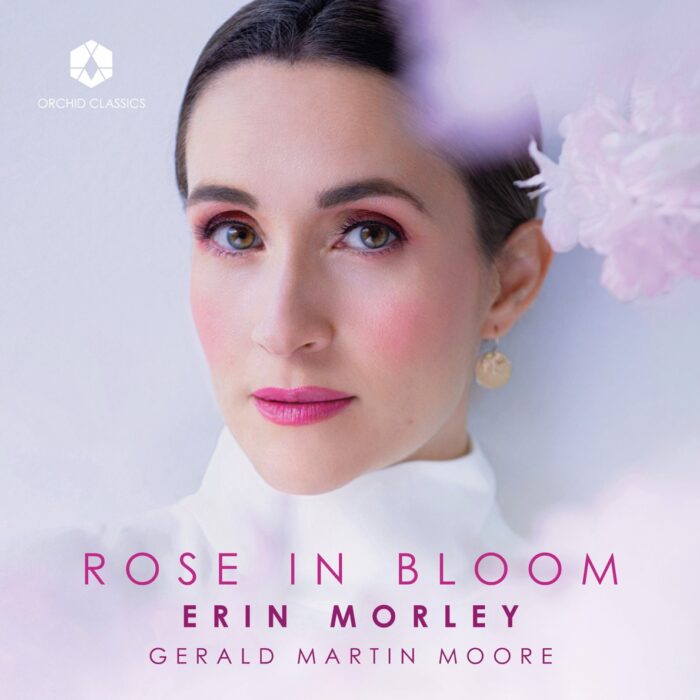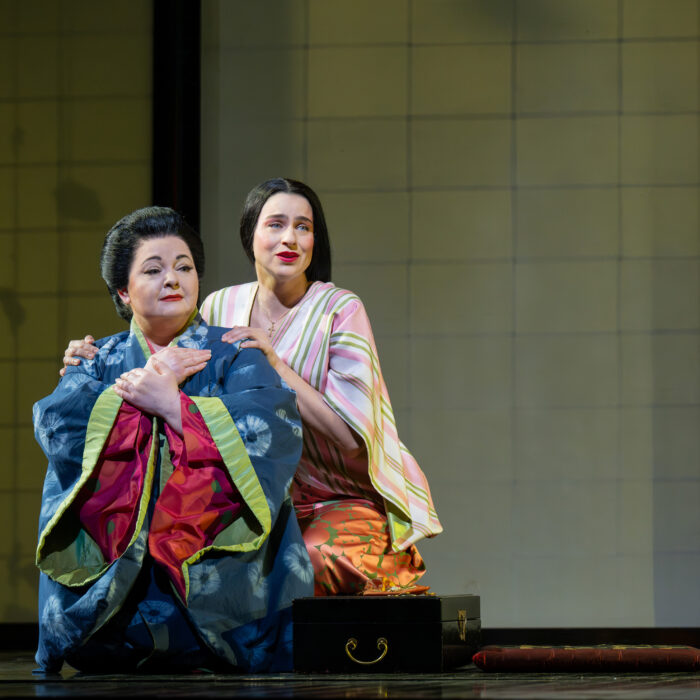
Opéra National de Paris 2021-22 Review: Don Giovanni
Nicole Car, Adela Zaharia, Anna El-Khashem Shine in Unbalanced Cast
By Mauricio Villa(Credit: Vincent Pontet)
Despite struggling with COVID’s incredibly contagious Omicron variant and subsequent cancelations as a result, the Opéra National de Paris still managed to stage Mozart’s masterpiece, “Don Giovanni.” It was a performance par excellence, where all the primary soloists were, remarkably, able to perform — due to high infection rates it is becoming increasingly common for covers to step into soloist roles at the last minute— while the choir and extras all performed behind the safety of masks.
An Awe-Inspiring Cast
American bass baritone Christian van Horn portrayed the titular role. He possess a beautiful, dark, round timbre that navigates freely through the passages of this difficult role. He was the most audible of his male colleagues onstage, though his voice did not project to the same level as that of his female colleagues. This had the effect of leaving his sound in “second place” when singing with the sopranos or in ensembles.
He offered up an exquisite lyrical interpretation of the famous duet “La ci darem la mano,” with a soaring mezza voce, however. He had perfect diction and intonation on the devilishly difficult aria “Fin ch’han dal vino,” where conductor Bertrand de Billy chose a modest tempo that favored the singer. Van Horn was consequently able to overcome the forte sound of the orchestra on such tremendous lines as “Se trovi in piazza qualche ragazza,” written constantly above the stave between C and E flat. This is a dangerous zone for low voices and an area which Van Horn sang through with determination, strength, and flexibility.
He seemed to have trouble in his second act aria “Deh vieni alla finestra,” however. I cannot be sure if his voice was not in top form on this night, or if he was tired, but he had trouble singing mezza voce above the stave, appearing to lack air, with some sounds coming across as unstable. This aria is very difficult because the voice is completely exposed: it has only a mandolin for accompaniment alongside pizzicato strings, all the while demanding the performer sing in a high tessitura. It didn’t feel like the right fit for his voice.
Conversely, his singing comes across powerful and exciting when taking on the more dramatic moments, as was seen in his incredible rendition of the final scene and his confrontation with the Commendatore. He even delivered an nearly impossible sustained high A natural, a note which is entirely out of the range of most bass-baritones, and that only a few baritones dare to attempt after a long night onstage. This is a note which has been interpolated by tradition, and it is not written in the score.
Polish bass Krzysztof Baczyk portrayed Leoporello. He has a beautiful bright bass timbre, but he lacked projection and his voice sounded distant, often hidden by the voices of his female colleagues. The tessitura of the role proved to be uncomfortable for the singer, and it showed in his first aria, “Madamina, el catalogo è questo,” which navigates constantly between high D and E. Here Baczyk was over-darkening and covering the sound, making constant changes in his timbre and muffled high notes. This character is ideal for a bass-baritone, and therefore any bass is very brave to attempt such a demanding role for his voice. I am confident that in lower roles that do not require excessive use of the upper register, Baczyk’s voice is freer and more voluminous.
That said, he gave a very personal and intelligent portrayal of Leoporello, avoiding any buffo cliches with believable acting. Most of Mozart’s low voice roles for males were written for bass-baritones, as the tessitura seems too high for basses and too low for baritones.
Romanian soprano Adela Zaharia performed the role of Donna Anna. When one hears her big, velvety, round sound, it is hard to believe that she has Lucia, Gilda, Konstanze and Bellini’s Elvira in her repertoire. Her voice sounds lyrical, and her projection is mesmerizing. One could hear her voice above the rest of the singers in the ensembles. She delivered an exquisite version of her first act aria, “Or sai chi l’onore,” with her homogeneous velvet timbre ringing clearly and with incredibly well-supported crescendos in the several sustained A naturals that appear throughout the piece. She had the opportunity to show her bel canto technique in the roulades and staccato high notes of her second act aria, “Crudele!…non mi dir,” which was performed impeccably and with great emotion.
From the first lines of her entrance aria, “Ah chi mi dice mai,” it was clear that Australian soprano Nicole Car’s interpretation of Donna Elvira was going to be a great success. She possess a lyric, dark voice with an incredible projection that envelopes the auditorium of Opéra Bastille. It did not matter where she was on the stage, her voice always sounded as if it was close to your ears. She had perfect breath control, with all the attacks of the notes being precise and clear. The scales that closed her aria were fluid up to three bright B flats. She was furious and menacing in “Ah fuggi il traditor,” keeping her voice flexible and delivering well supported high A naturals. Her brave interpretation of “Mi tradi quell’alma ingrata” received the biggest ovation of the night.
In my opinion the voices of the two sopranos sounded very similar in timbre and volume and therefore there was no contrast between the two characters. Donna Elvira has been played by mezzo-sopranos, whose voices can be used to better-reflect the extreme desperation of her mental state, while Donna Anna is usually sung by lighter voiced sopranos, to reflect the purity and innocence of her character. But this distinction made through voice type does not always happen—as one can hear when listening to the the vast discography of this opera—and Paris Opera was no exception.
Belorussian tenor Pavel Petrov sang the role of Don Ottavio who, in the absence of his second aria “Il mio tesoro,” is relegated to supporting lines, ensembles, and a single short aria. His voice seemed guttural, and he lacked projection, often sounding distant and small. He had trouble with Mozart’s style of “clean attack” singing, and some intervals of his single aria “Dalla sua pace” were sung with timid portamenti. Petrov did this to ensure the sound was in the correct position, but it completely broke the fluidity of the line “Dalla sua pace, la mia dipende,” as he prepared the high G before singing the consonants. To his credit he did deliver some pianissimo high G, however.
Russian soprano Anna El-Khashem sang the role of Zerlina with her sweet powerful crystalline voice and shone in a role that, although it has two arias and several duets, seems quite secondary after the strong personalities and shining arias of the two main sopranos. But it is the apparent simplicity of the vocal writing for this role which makes it very demanding and El-Khashem proved she was up to the task in style, with a pure clean attack of notes and fluid legato lines. She had the chance to show a darker side of this usually naïve character in the rarely performed duet with Leporello “Per queste tue manine,” where Zerlina becomes aggressive and even sadistic.
Ukrainian bass Alexander Tsymbalyuk sang the short—yet important—role of Il Commendatore. He seemed too young for the role, and his voice gave him away. It was not well-suited for a basso-profondo. The psychological impression of this character, which Mozart transcribed with such great talent into his score, is one of a strong, voluminous voice that presents an older, upper class gentlemen, a father and a vengeful ghost. Tsymbalyuk’s voice did not have the power, nor the projection, to sound menacing and strong. His sound is well-supported, and his timbre is even throughout his tessitura, and he is undeniably a good singer: I only believe that his voice was not ideal for such a strong, heavy role.
A Revolutionary Set Design
The Paris Opera presented a revival of their own production, directed by Ivo van Hove, which, along with set designs and lighting by Jan Versweyveld, costumes by An D’huys and projections by Christopher Ash, have created a powerful and meaningful adaptation of the famous myth of Don Juan.
The production’s use of its theatrical resources is so well-balanced that every scene is a surprise and a thrill to see: something very uncommon in modern performances, where stage effects are often overused, making productions repetitive and tedious. The sets were three concrete buildings with numerous doors, windows and stairs. The buildings were in a constant state of movement throughout the entire first act, but the movement was so slow that it could not be perceived: one only realized that the perspective of the stairs and walls had changed after a while. The effect was subtle but left a terrific impression. In Act two the audience, having grown accustomed to this aspect of the set, received a shock when the Commendatore appeared and the buildings suddenly turned around with great speed, creating a claustrophobic, enclosed space that represented the imprisonment of Don Giovanni. There are projections, used only in this scene, depicting thousands of persons moving. The images enlarge as the scene progresses, to finally show a group of people in the mud moving against each other. The effect was electrifying. Sets and costumes are in grey and light brown, reflecting the moral decay of the protagonist.
The buildings appear with curtains, flowers, hanging clothes and plants bursting from their balconies, turning these monolithic concrete abstractions into a naturalistic environment. The concept works fantastically and the effect of the lighting on the constantly moving and changing sets creates a sense of infinite possibilities. Van Hove opted for a naturalistic acting approach, making the several comical moments of the opera believable, as well as Don Giovanni’s final fight to save his soul from damnation.
French conductor Bertrand de Billy opted for a fast and frenzied tempi. The agile tempo of the Andante in the Overture marked the rhythm of the whole opera; he was precise with the dynamics and rallentando but always sustained a rapid tempo. This was in accordance with this opera as a whole: a performance Mozart classified as “dramma giocoso”—that is, a “comic play,” as “drama” did not have the sense of tragedy that it would later attain.
The overture, the final scene of Act one and Don Giovanni’s dinner in Act two were full of energy. De Billy knew he also had to obtain all the dramatism that the Paris Opera Orchestra could provide, in scenes like the beginning of the Overture, the killing of the Commendatore or the confrontation between Don Giovanni and the Commendatore—and this he executed perfectly. De Billy presented the Vienna version of the opera, which contains a single aria for Don Ottavio—”Dalla sua pace”—an extra buffo duet for Leoporello and Zerlina, and a new recitative for Donna Elvira before her second act aria “Mi tradi quellálma ingrata.” But instead of ending the opera with Don Giovanni descending into hell, de Billy maintained the buffo and moralistic ending of the Prague version with a final ensemble. The Paris Opera orchestra shone in the pit and the choir accomplished its brief appearances with excellence.
Overall, it was a splendid, dramatic production with a great cast of singers where the female voices outshone their male colleagues.


